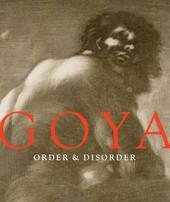
|
Goya: Order & Disorder
Hardback
Main Details
Description
Francisco Goya has been widely celebrated as the most important Spanish artist of the late eighteenth and early nineteenth centuries, the last of the Old Masters and the first of the Moderns, and an astute observer of the human condition in all its complexity. The many-layered and shifting meanings of his imagery have made him one of the most studied artists in the world. Few, however, have made the ambitious attempt to explore his work as a painter, printmaker, and draftsman across media and the timeline of his life. This book does just that, presenting a comprehensive and integrated view of Goya through the themes that continually challenged or preoccupied him, and revealing how he strove relentlessly to understand and describe human behavior and emotions even at their most orderly or disorderly extremes. Derived from the research for the largest Goya art exhibition in North America in a quarter century, this book takes a fresh look at one of the greatest artists in history by examining the fertile territory between the two poles that defined the range of his boundlessly creative personality.
ReviewsGoya: Order & Disorder automatically invites comparisons with Goya and the Spirit of Enlightenment, a volume produced a quarter century ago, when MFA Boston last presented a major Goya exhibition. The new book's title suggests a historical approach to its subject-like the earlier volume's-reflecting the massive changes in Spain and Europe during Goya's lifetime. Instead, it delivers a thematic, historically untethered account of Goya's achievement, making it hard to grasp how a young, savvy striver-many of whose commissioned works of the 1770s and early 1780s are underwhelming-evolved into the artist who created the bitingly satirical Caprichos in the late 1790s, who responded to Spain's brutal guerrilla war against French invaders with some of the most indelible images in Western art, and whose late work foreshadows, in the words of Fred Licht, the "modern temper in art." Goya and the Spirit of Enlightenment presents Goya's oeuvre in three chronological segments that segregate prints and drawings, which are uniquely important in Goya's oeuvre. The effect is to show the artist's transformation from a creature of the Age of Reason into a harbinger of our darker time. But the present book, organized thematically, scrambles the chronology of Goya's career, so that works with quite different audiences and aims (noble portrait versus piercing social critique) appear cheek by jowl. Gathered under the theme "Hunting" are anodyne early tapestry cartoons; an unintentionally comic print copying a royal portrait by Velazquez, whose subject poses as a hunter; and, from Los Caprichos, the print All Will Fall, in which bird men, lured by a beautiful harpy, are ensnared and tortured by women with evident relish, an image that crosses the line between moralizing allegory and penetrating psychology.--Christopher Lyon "Bookforum"
|